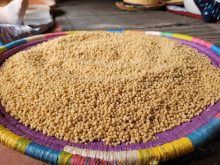SASKATOON — Durum carryout in 2023-24 could be more than double the amount Agriculture Canada is forecasting, says a trader of the crop.
Jonathan Meyer, a merchandiser with Purely Canada Foods, thinks it could end up at one million tonnes or even more.
Related stories:
Read Also

New coal mine proposal met with old concerns
A smaller version of the previously rejected Grassy Mountain coal mine project in Crowsnest Pass is back on the table, and the Livingstone Landowners Group continues to voice concerns about the environmental risks.
That is a far cry from the federal government’s forecast of 450,000 tonnes.
Meyer said Agriculture Canada is using Statistics Canada’s production estimate of 4.05 million tonnes, which many in the trade feel is 300,000 to 500,000 tonnes too low.
He also thinks Canada will struggle to meet the export target of 3.2 million tonnes, which is well below the previous year’s program of 5.05 million tonnes.
“Demand is next to nothing,” said Meyer.
“Without the tenders it’s hard to find a sale anywhere.”
Agriculture Canada is forecasting that farmers will plant 6.12 million acres of the crop this spring, a 1.4 percent increase over last year.
Meyer thinks the increase will be closer to two to four percent because despite prices dropping $1 per bu. in recent weeks, durum still has more than a $2 per bushel premium over spring wheat, which is on the historically high side.
“You throw all those things together and it’s not painting a real bullish durum story,” he said.
However, he noted that there are dry conditions in about 80 percent of Saskatchewan’s durum growing areas, so it could become a weather market at some point in the growing season.
There are also worrisome growing conditions in Canada’s top markets for the crop.
It is very dry in Italy, which is halfway through its growing season.
“They’ve got some time. It’s not panic time yet, but it’s definitely something to watch,” said Meyer.
The U.S. Department of Agriculture’s Foreign Agricultural Service (FAS) is forecasting 2.7 million tonnes of total wheat production in Algeria in 2024-25.
That would be the same amount as last year’s disappointing harvest, which was one million tonnes below the previous year.
Satellite images show that vegetation conditions are below average in the east and “significantly” below average in the central and western areas of the country.
FAS is forecasting that Algeria will import 8.7 million tonnes of wheat in 2024-25, matching this year’s anticipated record.
Early season rains were also “light and insufficient” in Morocco, according to the FAS. The crop got off to a late start due to rain arriving two months after the typical planting date.
The FAS will be issuing its first supply and demand estimates for Morocco’s 2024-25 crop on April 1.
The first report for Tunisia will be in March.
Meyer is having a hard time getting excited about the troubling conditions in the Mediterranean Basin.
“Everything is being overshadowed by these Turkey exports right now,” he said.
The country has come out of nowhere to become one of the most dominant players in the durum market.
Turkey’s durum exports during the first half of the marketing year (June to November) reached 1.35 million tonnes and it isn’t done yet. Just last week the country sold an additional 150,000 tonnes to Italy and Tunisia.
Canadian farmers have started delivering more durum into the system but there is nowhere for it to go, which has resulted in the recent $1 per bu. price drop for the crop, said Meyer.
“The clock is working against the farmer that is still holding durum,” he said.
Mexico’s harvest is in April-May, and farmers in the European Union will be harvesting their crops a month after that.
Contact sean.pratt@producer.com


















